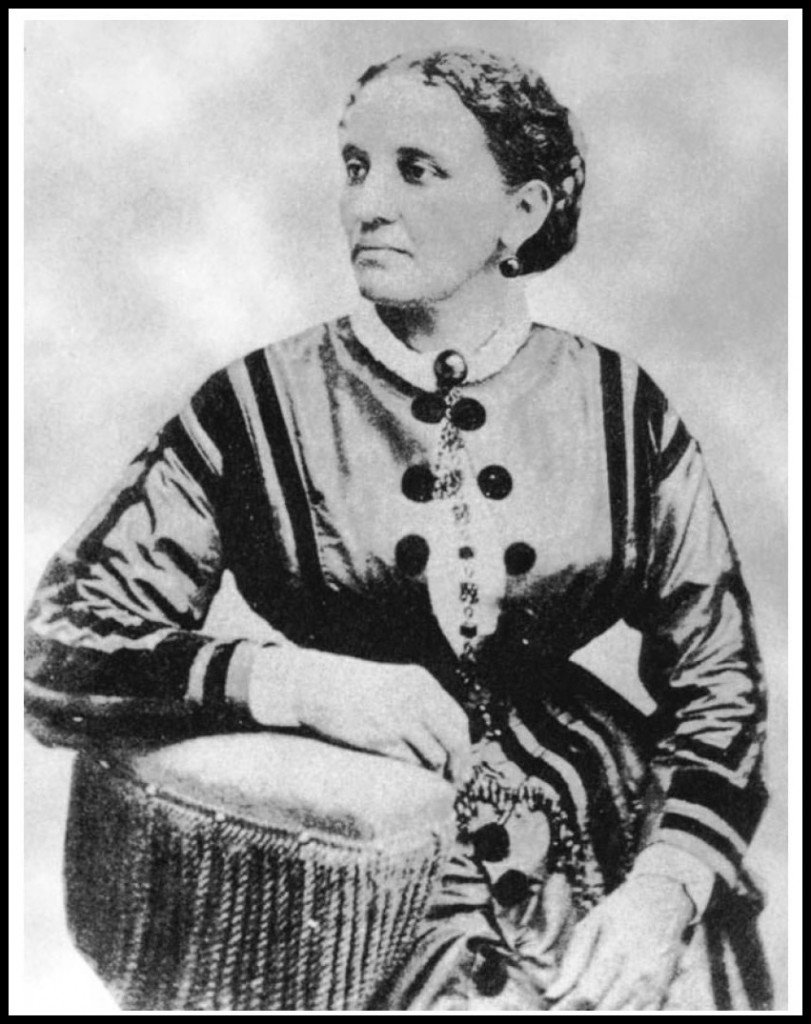When we were researching Mary Lincoln we both admired her friend, Elizabeth Keckly, so much that we knew that had to talk about her. She was born a slave, eventually bought her freedom and built a very successful business (twice) all before she, too, realized her own White House dream. Yes indeed- Lizzie needs her time in the spotlight.
Elizabeth was born the same year as her friend Mary Lincoln, although unlike Mary the exact date is unknown. Sometime in February of 1818 Agnes (Aggie) Hobbs gave birth to Elizabeth in the town of Dinwiddie Courthouse, Virginia. Aggie and Lizzie were slaves owned by Colonel Armistead Burwell. Her father of record, and in her heart, was George Pleasant Hobbs who was also a slave but owned by a different master. Later in life what Lizzie probably always knew was confirmed by her mother- her father of biology was none other than the Colonel.
Lizzie’s early life was sadly common for the times but being commonplace doesn’t take away the horrors of it, (and we do go into a lot more detail in the podcast.) She was whipped on her very first day of service at age four, moved with the family when the Colonel had a downturn of fortune to Hampden Sydney College and while Lizzie was still a child she saw her loving father for the last time when he was forced to move away. By the time she was a young teen she was separated from her mother and sent to live with the Colonel’s son Robert and his new wife, Anna.

Still a private, men’s liberal arts college in Virginia: motto (translated from Latin):Come here as boys so you may leave as men
Gooo, Tigers!
While Lizzie had very few choices in her life, she did have some things that could not be taken away from her: her mother and father could both read and write (an illegal rarity among slaves) and had taught her. Almost as importantly, Lizzie had an inner strength and natural grace that she held to tightly despite years of being told she was worthless, the many whippings she endured in an attempt to “put her in her place” and years of allowed (or encouraged) sexual abuse by a nearby plantation owner that did leave her with one bright spot in her life: her son, George.
When Lizzie and her mother were and sent to live with another Burwell- a daughter and her lawyer husband first in Virginia and then St. Louis, Missouri, Mr. Garland wanted to lend Aggie out as a dressmaker. Lizzie was appalled at the thought of her aging mother working for strangers, so she volunteered instead.
Wise move, Lizzie.
Lizzie was not only skilled with a needle and thread, but she had a gift for draping fabric and an a strong business mind. She soon built up a very prestigious list of customers…and kept handing the money over to the Garlands. But Lizzie wanted something else for her life: Freedom. She asked Mr. Garland how much she would need to buy her and her son’s freedom. Long story short (long version of this story and a lot more details are on podcast), after asking maaaaany times he gave her a figure of $1200 which gave Lizzie hope for her future, so much so that she married James Keckly…
…a lying, drinking, not-so-great husband. James was NOT free like he had told her and to make her situation worse (yeah, worse) saving any money was nearly impossible– the Garlands took everything. For eight years she tried to save, tried to make her marriage work…but really? The only thing she succeeded in doing was building her reputation as an extraordinary dressmaker. We go into detail in the podcast of the plans she tried to make the money but in the end it was her reputation among her clients that got her the funds to buy her freedom.
Newly free George went off to college and Lizzie headed to Baltimore to work as a dressmaker. But do things ever work out like she plans? They do not. Baltimore wasn’t the place for her so she moved a little south to Washington with her new dream: to work in the White House.
This is where Lizzie’s story meets up with Mary Lincoln’s. Through a series of wise business and networking steps (take note entrepreneurs) Lizzie became a sought after dressmaker and added Mary to her list of clients. Goal? Check!
But what happens when Lizzie’s life starts to go well? Yeah, bad stuff. As soon as the War Between the States broke George join the fight (as a white man, as a black it would have been illegal) in the Union army. 18 year-old George didn’t make it long and was killed in battle only a short time later.
Lizzie distracted herself from her grief with dressmaking work and the Lincoln’s. She was there when Abe needed his hair combed or help with one of Mary’s temper tantrums. She was there when the young Lincoln’s, Willie and Tad, were sick and she was there when little Willie didn’t survive. She was there when Mary had her get-out-of debt schemes and she was there when Mary needed to vent.
Mary was there for Lizzie, too,. When Lizzie formed the first Black Contraband Organization to help the newly freed people streaming in from the south become established in their new lives, Mary contributed money, goods and a great deal of time.
But when Abe Lincoln was assassinated their friendship was put to the test. Well, Lizzie’s was, anyway. She closed her business down to help Mary move and get settled in Chicago. Time and again Mary told Lizzie that she would compensate her. Mary was eventually given her portion of the Lincoln estate (Ol’ Abe, the lawyer? He died without a will), but did she take care of Lizzie like she had promised? Nope.
For a variety of well-intentionrf reasons Lizzie decided to write a memoir. But, we know now, things don’t always work out for Lizzie. Either by accident or design on the part of Lizzie’s editor, many personal letters from Mary were published in Lizzie’s book, Behind the Scenes or 30 Years a Slave and Four in the White House.
The fallout was life ruining. Feeling betrayed, Mary ended their relationship and Lizzie’s reputation as a confidant was ruined. No one wanted her near their private lives anymore and her business tanked. AND…ouch…the book never made her any money.
For many years afterward she did what she could including teaching at the college George had attended, Wilberforce University in Ohio ( there is a cameo by our favorite world’s fair, the 1893 Columbia Exposition.) When her health declined she moved into The Home for Destitute Women and Children in Washington, DC, a place she had helped establish back in her Contraband Organization days.
When she died in her sleep at the age of 88 on May 26th, 1907, Lizzie still had a picture of Mary over her dresser.
TIME TRAVEL WITH THE HISTORY CHICKS
Let’s get the burning questions out of the way first:
What’s the deal with the two spellings of Lizzie’s last name? Documents signed by Lizzie use Keckly, while other documents (including her book) use Keckley. We thought we would listen to her.
Was Jefferson Davis REALLY captured in a dress? Read all about it here at the American Heritage Society!
Books!
Read Lizzie’s book for freeeee! Behind the Scenes or 30 years a Slave and four years in the White House on Project Gutenburg
OR listen to it for the same $0.00 on LibriVox!
Roadside plaque location for Lizzie is in Hillsborough North Carolina:
Smithsonian article about her dressmaking
Surratt House Museum— now a Civil War museum with focus on Lincoln Assassination AND with directions to Lizzie’s grave.
History of Elizabeth Keckley Mary Todd Quilt













